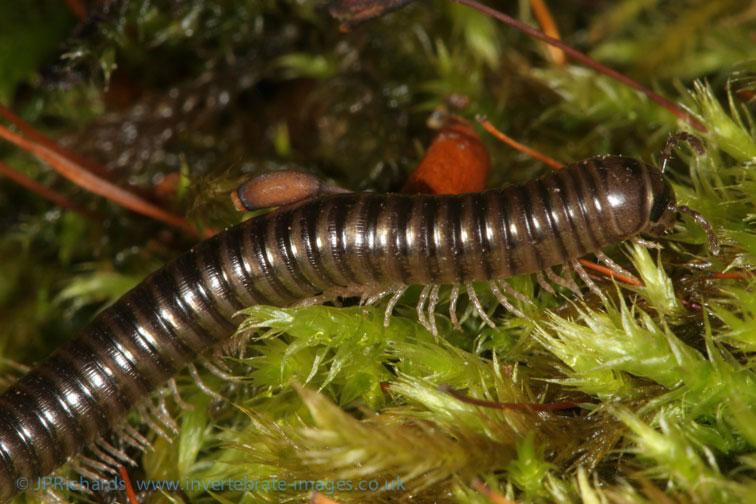Cylindroiulus caeruleocinctus (Wood, 1864)
Status:
GB IUCN status: Least Concern
ID Difficulty
Identification
This is a distinctive species due to its large size (to 30 mm in length), typical blue-bronze appearance and completely lacking a projecting telson (tail). It is most likely to be confused with Cylindroiulus londinensis, but this species is larger and has a projecting club-shaped telson.
Other similar sized darkly pigmented species, such as Julus scandinavius or Tachypodoiulus niger have a projecting pointed telson, and those species lacking a projecting telson, such as Cylindroiulus britannicus, are much smaller in size (less than 20 mm in length).
Distribution
This species is found most frequently in the south and east of England. There are only scattered records from Wales and from south west England but its range extends northwards as far as Aberdeen along the east coast of Scotland. The few Irish records are mainly restricted to the southern and eastern coasts.
This species has an extended Atlantic distribution from Portugal to southern Scandinavia and extending eastwards through the Baltic. It is most frequently recorded in a restricted area stretching from the Alps to Denmark and southern Sweden (Kime, 1999).
Habitat
Although this species has been collected from a wide range of habitats, analysis of the recording scheme habitat data suggests it is synanthropic showing very strong associations with cultivated land and churchyards and a strong association with parks and other open spaces.
In continental Europe the species is also synanthropic (Kime, 2004; Pedroli-Christen, 1993) but Kime (1997) found it to be common on grassland in Belgium, especially on calcareous soils. Blower (1985), Haacker (1968) and Pedroli-Christen (1993) have all noted a link with calcareous soils and analysis of the British and Irish data strongly supports such an association. However, Kime (1995) has suggested this association results from the millipede’s ability to withstand the dry conditions on these soils rather than a requirement for a base-rich substrate.
Phenology
Animals move deep into the soil to overwinter or to aestivate during dry summer conditions. Peaks of activity occur as they emerge in the spring and autumn (Kime, 2004). Adults have been found throughout the year.
This species account is based on Lee (2006).
Links
MilliBase - Global catalogue of Millipedes: https://millibase.org/aphia.php?p=taxdetails&id=947881








